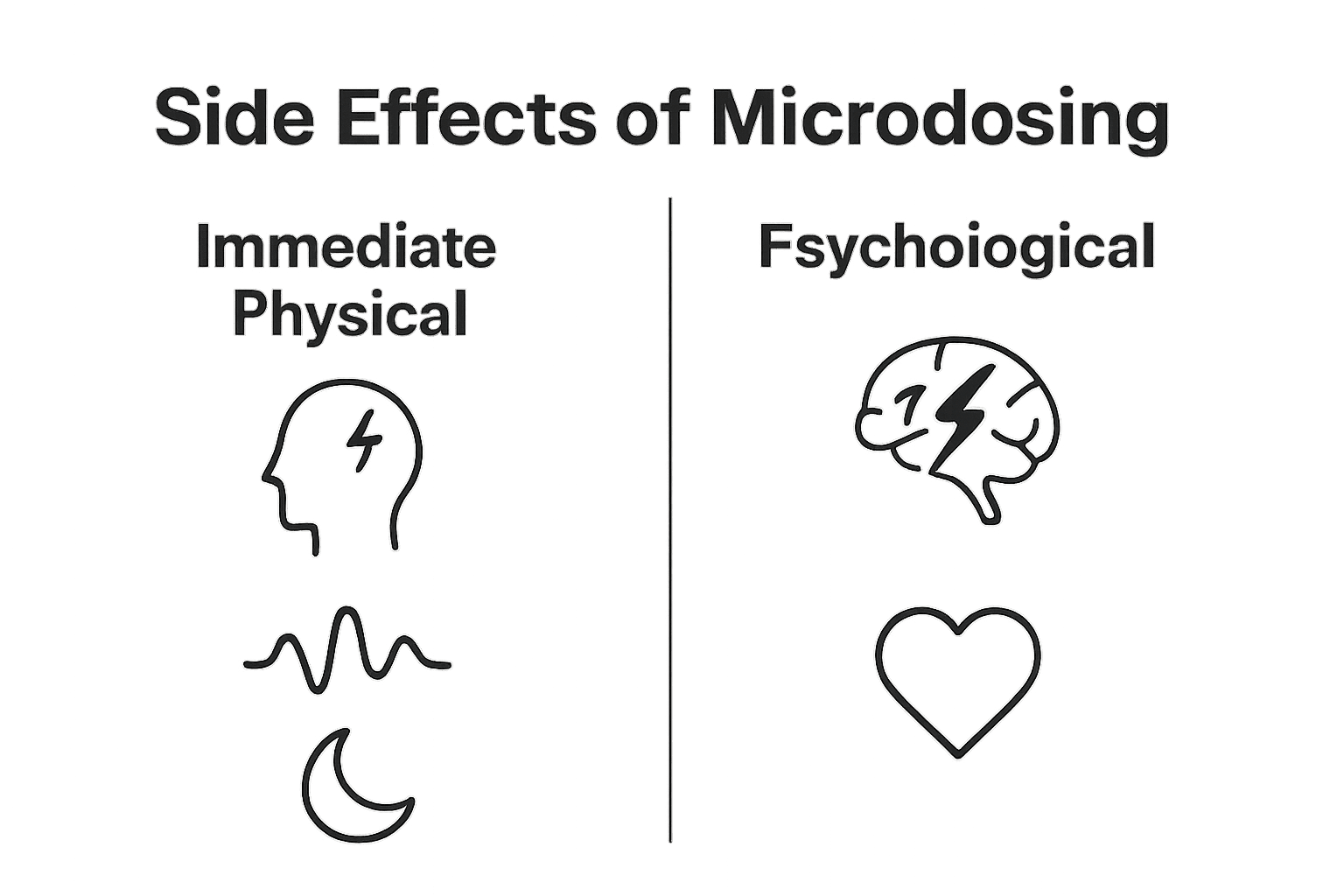Microdosing is getting attention for its subtle effects on mood and mental clarity. Some people now take doses as tiny as one tenth of a typical psychedelic amount to try to sharpen focus or ease anxiety. It sounds gentle and almost harmless at first. Yet what surprises many is that these almost invisible amounts can still cause real shifts in brain chemistry and body balance. The science behind it flips assumptions about how little it takes to make a difference.
Table of Contents
- What Is Microdosing? An Overview
- Why Microdosing Matters For Mental Health
- How Microdosing Affects The Brain And Body
- Common And Less Known Microdosing Side Effects
- Navigating The Risks Of Microdosing For Wellness
Quick Summary
| Takeaway | Explanation |
|---|---|
| Microdosing involves very small doses | Microdosing typically uses 1/10th to 1/20th of standard psychedelic doses to avoid hallucinations while enhancing wellness. |
| Potential benefits for mental health exist | Research suggests microdosing could help in managing anxiety, depression, and emotional regulation effectively. |
| Legal and health risks are present | Users must understand legal regulations and potential interactions with medications before considering microdosing. |
| Effectiveness still requires research | Ongoing studies are needed to validate the claims surrounding microdosing’s neurological benefits for mental health. |
| Professional guidance is essential | Consulting healthcare professionals before starting a microdosing regimen ensures responsible and informed decisions. |
What is Microdosing? An Overview
Microdosing represents an emerging wellness approach involving the consumption of extremely small quantities of psychedelic substances, specifically designed to provide subtle cognitive and emotional benefits without inducing significant perceptual alterations. Researchers at Johns Hopkins University define microdosing as consuming sub-hallucinogenic doses that typically range between 1/10th to 1/20th of a standard recreational psychedelic dose.
Understanding the Basics
At its core, microdosing involves consuming minimal amounts of substances like psilocybin mushrooms or LSD with the primary goal of enhancing mental performance, emotional regulation, and overall psychological wellness. Unlike traditional psychedelic experiences characterized by intense hallucinations and profound alterations in consciousness, microdosing aims to create subtle, almost imperceptible improvements in daily functioning.
This table summarizes the key differences between microdosing and traditional psychedelic use, helping readers understand their contrasting features and wellness goals.
| Aspect | Microdosing | Traditional Psychedelic Use |
|---|---|---|
| Dose Size | 1/10th to 1/20th of standard dose | Full recreational dose |
| Perceptual Effects | None or subtle; no hallucinations | Intense perceptual changes, hallucinations |
| Intended Purpose | Cognitive enhancement, emotional regulation | Profound consciousness alteration, spiritual exploration |
| Duration of Effects | Mild and short-lasting changes | Intense and longer-lasting experiences |
| Suitability for Daily Function | Generally maintains daily function | Typically disrupts normal functioning |
Key characteristics of microdosing include:
- Extremely low substance quantities
- No significant perceptual changes
- Focused on incremental cognitive enhancement
- Systematic and controlled consumption
Theoretical Foundations
The theoretical basis for microdosing stems from emerging neuroscientific research suggesting that sub-perceptual doses can potentially modulate brain connectivity, neuroplasticity, and neural network functioning. Neuroscience studies indicate that these minimal doses might interact with serotonin receptors, potentially influencing mood regulation, cognitive flexibility, and emotional processing without triggering the intense psychedelic experiences associated with larger doses.
For those interested in understanding more about structured microdosing approaches, our comprehensive microdosing schedule guide provides detailed insights into safe and effective implementation strategies. By approaching microdosing with careful research, medical guidance, and a systematic methodology, individuals can explore this innovative wellness technique with informed awareness and measured expectations.
Why Microdosing Matters for Mental Health
In an era of increasing mental health challenges, microdosing emerges as a potential alternative approach to traditional mental wellness strategies. Recent research suggests that microdosing psychedelics might offer promising pathways for individuals struggling with treatment-resistant mental health conditions, providing nuanced neurological support beyond conventional pharmaceutical interventions.
Addressing Mental Health Challenges
Traditional mental health treatments often involve pharmaceutical interventions with significant side effects and variable efficacy. Microdosing represents a potential complementary approach that targets underlying neurological mechanisms with minimal perceptual disruption. The subtle neurochemical modulation associated with microdosing could potentially help individuals manage symptoms of depression, anxiety, and emotional instability more organically.
Key potential mental health benefits include:
- Enhanced emotional regulation
- Reduced anxiety symptoms
- Improved stress resilience
- Potential mood stabilization
- Incremental cognitive flexibility
Neurological Mechanisms and Potential
The underlying neurological potential of microdosing stems from its interaction with serotonin receptors and neural network connectivity. By introducing minute quantities of psychedelic compounds, individuals might experience subtle neuroplastic changes that support emotional processing and psychological adaptability. Ongoing neuroscience studies continue to explore these intricate neurological pathways, suggesting promising implications for mental health management.
For those interested in exploring holistic approaches to mental wellness, our guide on psilocybin and social anxiety provides deeper insights into how alternative wellness strategies might complement traditional mental health treatments. Understanding microdosing requires an open yet critical perspective, acknowledging both its potential benefits and the need for continued scientific research.
How Microdosing Affects the Brain and Body
Microdosing triggers complex neurological interactions that extend far beyond simple substance consumption. Physiological research reveals subtle yet significant changes in brain chemistry and bodily responses when individuals engage with sub-perceptual psychedelic doses.
Neurochemical Interactions
The primary mechanism of microdosing involves intricate interactions with serotonin receptors, particularly the 5HT2A receptor network.
These interactions potentially modulate neural connectivity, enabling more flexible cognitive processing and emotional regulation. Unlike traditional pharmaceutical interventions, microdosing appears to work through neuroplastic mechanisms that gently reshape neural pathways without overwhelming the neurological system.
Key neurological engagement points include:
- Subtle serotonin receptor modulation
- Enhanced neural network connectivity
- Potential neurogenesis stimulation
- Reduced inflammatory neural responses
- Improved cognitive flexibility
Physiological Response Patterns
Physiological responses to microdosing are characterized by minimal yet measurable changes. Individuals might experience slight variations in heart rate, metabolic processes, and stress hormone levels. These modifications suggest a nuanced bodily adaptation that differs significantly from the intense physiological reactions associated with full psychedelic experiences.
Interestingly, the body’s response appears to be more about systemic recalibration than dramatic transformation. Microdosing seems to encourage homeostatic adjustments, potentially supporting overall physiological balance. Our comprehensive guide on microdosing creativity provides additional insights into how these subtle neurological shifts might influence cognitive performance and creative thinking.
Common and Less Known Microdosing Side Effects
While microdosing offers potential wellness benefits, understanding its comprehensive side effect profile is crucial for responsible use. Scientific research highlights a spectrum of physiological and psychological responses that individuals might experience during microdosing protocols.
Immediate Physical Responses
Microdosing can trigger a range of subtle physical reactions that vary among individuals. These responses are typically mild and transient, representing the body’s initial adaptation to neurochemical shifts. Some users report experiencing temporary physiological adjustments that do not necessarily indicate a significant health concern.
Common immediate physical side effects include:
- Mild headaches
- Temporary digestive changes
- Slight variations in energy levels
- Minor sleep pattern disruptions
- Occasional increased heart rate
Psychological and Cognitive Side Effects
Beyond physical responses, microdosing can produce nuanced psychological side effects that demand careful self monitoring. Some individuals might experience heightened emotional sensitivity, increased anxiety, or subtle cognitive alterations. These effects underscore the importance of individualized approaches and professional guidance when exploring microdosing strategies.
Potential psychological side effects encompass:

- Increased baseline anxiety
- Emotional amplification
- Occasional mood fluctuations
- Enhanced introspective awareness
- Temporary cognitive recalibration
Important Disclaimer: Individual responses to microdosing vary significantly. Our comprehensive guide on psilocybin side effects provides deeper insights into potential risks and mitigation strategies. Consulting healthcare professionals and maintaining a structured, informed approach remains critical for safe exploration of microdosing wellness techniques.

Navigating the Risks of Microdosing for Wellness
Microdosing, while promising, requires a nuanced understanding of potential risks and responsible implementation. Scientific research emphasizes the critical need for cautious and informed approaches to minimize potential adverse outcomes.
Legal and Regulatory Considerations
The legal landscape surrounding psychedelic substances remains complex and varies significantly across jurisdictions. Individuals considering microdosing must first understand the regulatory environment, recognizing that possession and consumption of certain substances could carry significant legal implications. Navigating these regulatory frameworks requires comprehensive research and potentially consulting legal professionals who specialize in controlled substance regulations.
Key legal risk factors include:
- Variable international and regional legal statuses
- Potential criminal penalties
- Uncertainty in substance classification
- Evolving regulatory frameworks
- Potential workplace and professional consequences
Medical and Personal Health Risks
Microdosing introduces potential medical risks that demand careful personal health evaluation. Individuals with pre-existing mental health conditions, neurological disorders, or those taking specific medications should exercise extreme caution. Potential interactions with existing pharmaceutical treatments could trigger unexpected physiological or psychological responses.
Significant health considerations encompass:
- Potential medication interactions
- Underlying mental health vulnerabilities
- Individual biochemical variations
- Possible exacerbation of anxiety
- Unpredictable neurochemical responses
Critical Awareness: Responsible exploration requires comprehensive personal research and professional medical consultation. Our guide on microdosing risks for Canadian consumers provides deeper insights into navigating these complex wellness considerations. Professional medical guidance remains paramount in determining individual suitability for microdosing protocols.
Discover a Worry-Free Microdosing Experience for Wellness
Are you concerned about the possible side effects of microdosing and searching for reliable ways to support your wellness journey? It is normal to have questions about how microdosed products may affect your body and mind, especially when your goal is mental clarity, focus, or emotional balance. If you are looking for science-backed solutions and educational guidance on microdosing, explore our MICRODOSING Archives for practical resources and real stories from people addressing the same pain points you are experiencing.

Step confidently into a new routine with our carefully formulated psilocybin capsules and gummies. At Kind Stranger, you will find detailed dosing protocols, safety considerations, and honest answers on everything from stacking to legal questions. Remember, breakthroughs in mental wellness start with trusted information and high-quality products. Visit our Mental Health Archives or shop directly on our main site. Make your wellness a priority now and see the difference a mindful approach can bring.
Frequently Asked Questions
What are the common side effects of microdosing?
Microdosing can lead to subtle physical responses such as mild headaches, temporary digestive changes, slight variations in energy levels, and minor sleep pattern disruptions. Emotional responses can include heightened emotional sensitivity and occasional mood fluctuations.
To clarify the types of side effects discussed throughout the article, the following table organizes common and less known physical and psychological side effects of microdosing for easier comparison.
| Side Effect Type | Example Side Effects |
|---|---|
| Immediate Physical Responses | Mild headaches, temporary digestive changes, variations in energy levels, minor sleep disruptions, occasional increased heart rate |
| Psychological/Cognitive Reactions | Increased anxiety, emotional amplification, mood fluctuations, enhanced introspective awareness, temporary cognitive recalibration |
How do microdosing side effects differ between individuals?
Individual responses to microdosing can vary significantly based on unique biochemical variations, existing mental health conditions, and personal health evaluation. This can influence both physical and psychological side effects experienced during microdosing.
Can microdosing lead to increased anxiety?
Some individuals may experience increased baseline anxiety or emotional amplification as side effects of microdosing. Monitoring your emotional state during microdosing is essential to address these potential concerns.
Is it necessary to consult a healthcare professional before starting microdosing?
Yes, consulting a healthcare professional is crucial to evaluate personal health risks and potential interactions with medications, particularly for individuals with pre-existing mental health conditions or those taking specific medications.
Recommended
- Microdosing and Meditation: Enhance Focus and Wellbeing in 2025 • KIND STRANGER
- Psilocybin Microdosing Schedule Guide 2025: Safe and Effective Plans • KIND STRANGER
- Psilocybin for Social Anxiety: Natural Relief in 2025 • KIND STRANGER
- Psilocybin Side Effects: What Wellness Seekers Need to Know 2025 • KIND STRANGER


Comments
There are no comments yet.